Is lamictal a good mood stabilizer
Lamotrigine (Lamictal) for Bipolar Depression: What You Should Know
Lamotrigine (brand names include Lamictal, Lamictal CD, Lamictal ODT, Lamictal XR) is an anticonvulsant medication that is also used with other medications in the treatment of bipolar (manic-depressive) disorder. For the latest information on the use of lamotrigine, we turned to Joseph Goldberg, MD, Clinical Professor of Psychiatry at the Icahn School of Medicine at Mount Sinai in New York, and co-author of Managing the Side Effects of Psychotropic Medications, (2nd edition), a textbook published by American Psychiatric Association Publishing. Here, a Q and A with Dr. Goldberg:
Which conditions are treated with lamotrigine?
Although lamotrigine is not considered an antidepressant, it is used as a maintenance treatment for bipolar I disorder in patients 18 and older to help stabilize mood changes. (Bipolar I disorder is characterized by manic episodes.) ¹˒²
“The drug manufacturer’s original studies of lamotrigine in bipolar depression found that improvements were stronger in bipolar 1 than bipolar II disorder,” Dr. Goldberg says. (Bipolar II disorder is characterized by longer episodes and more frequent occurrence of major depression and hypomania.) Newer research suggests, however, that lamotrigine may be even more effective as a mood stabilizer in preventing relapses in treating bipolar II disorder.²
How does lamotrigine work?
Lamotrigine delays the time between mood changes and manic or depressive states in people with bipolar disorder by decreasing the intensity of irregular electrical activity in the brain. People with bipolar disorder are at high risk of experiencing recurrent and relapsing episodes of mood change. Maintenance treatment with lamotrigine helps reduce the risk by preventing or delaying these recurrences and relapses.
“Many clinicians think that lamotrigine helps achieve and sustain even moods over time by virtue of its antidepressant properties, rather than anti-manic (mood-stabilizing) properties,” says Dr. Goldberg. “It works with mood stabilizers like lithium and divalproex, but it’s not interchangeable with these drugs and cannot be used in their place. ”
”
Also, the efficacy of lamotrigine appears to be similar to the effects of lithium yet is better tolerated compared to lithium.
Lamotrigine is used over time as a preventative medication. Clinical trials that looked at lamotrigine’s potential for treating acute (in-the-moment) episodes of mania found no difference between the medication and placebo. ²
Is there a typical dose of lamotrigine?
Your doctor will initially prescribe a low dose of lamotrigine and gradually increase your dose every week or two for several weeks, until you reach an effective dose level.
“Treatment guidelines for target blood levels of lamotrigine have not been established for conditions other than epilepsy,” Dr. Goldberg points out. “In relapse prevention studies conducted by its manufacturer, however, 200 mg/day was found to be a better target dose than 50 mg/day, while higher doses (400 mg/day) did not provide greater benefit against relapse.”
The dosing regimen of lamotrigine can depend on which other medications you are taking to treat bipolar disorder and is adjusted when you wean off and discontinue other medications. ³ Other factors that may impact the dose are the condition it is prescribed to treat and patient age.
³ Other factors that may impact the dose are the condition it is prescribed to treat and patient age.
“Some medicines slow down the metabolism of lamotrigine (notably, divalproex), requiring a slower rate of increase and a lower target dose,” notes Dr. Goldberg. “Others speed up its metabolism (notably, carbamazepine), requiring a faster-than-usual dose increase and a higher-than-usual target dose.”
Lamotrigine comes in several forms for treating bipolar disorder: Tablets, chewable tablets, and dissolving tablets. Your doctor may tell you to take tablets once a day, twice a day, or every other day.
If you miss a dose of lamotrigine, take the missed dose as soon as you remember. If it is close to the time of your next dose, however, skip the missed dose and continue with your usual schedule. Never take a double dose of lamotrigine.
Are there side effects associated with taking lamotrigine?
Some people who take lamotrigine may experience adverse reactions, or side effects. In approximately 8 in 10,000 people, lamotrigine can cause severe, life-threatening rashes and other skin disorders that may require hospitalization or discontinuation of treatment. These occur typically between the second and eighth weeks of treatment. The risk of rash increases with higher starting doses, higher escalating doses, and use of lamotrigine in combination with valproate. ³ Early clinical trials and follow-up research showed that the overall incidence of any skin disorders was 11% to 12% in both bipolar I and bipolar II patients treated with lamotrigine. ²
In approximately 8 in 10,000 people, lamotrigine can cause severe, life-threatening rashes and other skin disorders that may require hospitalization or discontinuation of treatment. These occur typically between the second and eighth weeks of treatment. The risk of rash increases with higher starting doses, higher escalating doses, and use of lamotrigine in combination with valproate. ³ Early clinical trials and follow-up research showed that the overall incidence of any skin disorders was 11% to 12% in both bipolar I and bipolar II patients treated with lamotrigine. ²
“Most of these skin issues are benign,” Dr. Goldberg emphasizes. “Serious rashes from lamotrigine are not due to an allergy, but rather, a systemic reaction that also usually includes fever, sore throat, swollen glands, and other physical symptoms.”
But as with any medication, Dr. Goldberg adds, allergic reactions to lamotrigine can occur. Get immediate emergency help if you show any signs of an allergic reaction, such as hives, facial or throat swelling, or difficulty breathing. Notify your doctor if you develop a skin rash, especially if it occurs within your mouth or on soft body tissue such as eyelids or around nasal openings, and if it is blistering, peeling, painful, burning, or involves a fever or sore throat. Be sure to report all medications you are taking to medical staff.
Notify your doctor if you develop a skin rash, especially if it occurs within your mouth or on soft body tissue such as eyelids or around nasal openings, and if it is blistering, peeling, painful, burning, or involves a fever or sore throat. Be sure to report all medications you are taking to medical staff.
Serious side effects that should be reported immediately to your doctor include:
Any skin rash, blistering or peeling of skin
Painful (burning) sores in or around the mouth, eyes or genitals
Jaundice (yellowish skin or eyes)
Swollen glands, fever, severe muscle pain
Weakness, drowsiness, confusion
Stiff neck, headache
Increased sensitivity to light
Mood or behavior changes, such as depression, anxiety, agitation, hostility, restlessness, mental or physical hyperactivity, suicidal thoughts
Common side effects of lamotrigine that are not emergencies but should also be reported to your doctor include:
Headache or dizziness
Blurred or double vision
Dry mouth
Gastrointestinal distress such as nausea, vomiting, diarrhea, or stomach pain
Fever, sore throat, runny nose
Drowsiness or fatigue
Tremor
Insomnia
Who can (and cannot) take lamotrigine for bipolar disorder?
Doctors may prescribe lamotrigine to adults or adolescents who are otherwise being treated for bipolar disorder or weaning off other medications used to treat bipolar disorder. Older adults may be more sensitive to the effects of lamotrigine and prescribed lower doses.
Older adults may be more sensitive to the effects of lamotrigine and prescribed lower doses.
Children under age 18 are at higher risk of developing a skin rash from lamotrigine, if dosed too rapidly. In spite of the potential side effects, however, Dr. Goldberg points out that many studies support the use of lamotrigine for treating bipolar disorder in youth.
Definitive information about the safety of lamotrigine in pregnancy is not available, as there are no adequate studies in a pregnant women population, but according to Dr. Goldberg, many doctors perceive it to be among the safer options when treatment benefit outweighs risk to fetus, especially in women who are more prone to depression than mania.
Like many psychotropic drugs, lamotrigine is secreted into breast milk, so women are advised to discuss with their doctors the risk and benefits of breastfeeding while taking lamotrigine.
Lamotrigine is NOT recommended in patients who have demonstrated hypersensitivity to the medication or any of its ingredients.
Certain other drugs can affect the way lamotrigine works in your body by decreasing its effectiveness or delaying its excretion from your body. These include hormonal birth control methods, estrogen-containing contraceptives, seizure medications such as phenobarbital, and valproic acid, which is also used to treat bipolar disorder. Your doctor will carefully prescribe and monitor your dosage when lamotrigine is taken with other treatments.
Avoid alcohol, cannabis, and other substances that can increase dizziness or drowsiness while taking lamotrigine. To rule out dangerous side effects, discuss all other medications or mind-altering substances you consume with your doctor before taking lamotrigine.
Is it OK to suddenly stop taking lamotrigine?It is NOT recommended to discontinue lamotrigine abruptly as this may increase risk of seizures. Consult your doctor before stopping lamotrigine. If you do stop for more than a few days, DO NOT restart at your current dose. Call your doctor to review your dosing schedule.
If you do stop for more than a few days, DO NOT restart at your current dose. Call your doctor to review your dosing schedule.
- MedlinePlus. Lamotrigine. Available at: https://www.medlineplus.gov/druginfo/meds/a695007.html. Accessed June 17, 2019.
- Terao T, Ishida A, Kimura T. Preventive effects of lamotrigine in bipolar II versus bipolar I disorder. The J Clin Psychiatry. September 1, 2017; 78(8): e1000-e1005. Available at: https://www.psychiatrist.com/JCP/article/Pages/2017/v78n08/16m11404.aspx. Accessed June 17, 2019.
- Mago R, Borra D, Mahajan R. Role of Adverse Effects in Nonadherence to Mood Stabilizers for Bipolar Disorder. Simple and Practical Mental Health. Available at: https://www.simpleandpractical.com/publications. Accessed June 17, 2019.
Notes: This article was originally published June 18, 2019 and most recently updated August 12, 2022.
Psychiatric Uses of Lamotrigine
Lamotrigine (Brand names: Lamictal, Lamictal CD, Lamictal ODT, Lamictal XR)Like other mood stabilizers, lamotrigine was originally developed as an anticonvulsant to treat seizures and is often used with other medications in the treatment of bipolar (manic-depressive) disorder. For the latest information on the use of lamotrigine, Psycom spoke with Joseph Goldberg, MD, Clinical Professor of Psychiatry at the Icahn School of Medicine at Mount Sinai in New York, and co-author of Managing the Side Effects of Psychotropic Medications, 2nd Ed, a textbook published by American Psychiatric Association Publishing and Christopher Aiken, MD, the director of the Mood Treatment Center in North Carolina.
For the latest information on the use of lamotrigine, Psycom spoke with Joseph Goldberg, MD, Clinical Professor of Psychiatry at the Icahn School of Medicine at Mount Sinai in New York, and co-author of Managing the Side Effects of Psychotropic Medications, 2nd Ed, a textbook published by American Psychiatric Association Publishing and Christopher Aiken, MD, the director of the Mood Treatment Center in North Carolina.
Lamotrigine is the only mood stabilizer that calms mood swings by lifting the depression rather than suppressing the mania, says Dr. Aiken. "That makes it a great choice for the bipolar spectrum, where the depressive symptoms usually outweigh the manic ones. Its greatest benefit is in prevention. It can prevent both the depressive and manic side, but its benefits are much stronger for depression and it does not treat active mania or hypomania."
Dr. Aiken adds that part of the reason patients prefer lamotrigine is that it’s generally well tolerated. "In the original research studies people reported more side effects on the placebo than on lamotrigine. That may sound impossible, but it’s likely that lamotrigine helped them feel better physically by treating their depression," explains the mood disorder expert adding that lamotrigine is also largely free of the “medicated” feelings that people dislike with mood stabilizers. "People don’t tend to feel dull, flat, or groggy on it."
"In the original research studies people reported more side effects on the placebo than on lamotrigine. That may sound impossible, but it’s likely that lamotrigine helped them feel better physically by treating their depression," explains the mood disorder expert adding that lamotrigine is also largely free of the “medicated” feelings that people dislike with mood stabilizers. "People don’t tend to feel dull, flat, or groggy on it."
In some research studies comparing a placebo to the medicine, the results were exceptional. "Lamotrigine is the only medicine we know of where patients were unable to tell they were taking the medication," he explains. "It didn’t make them feel medicated, and its benefits built up very gradually. After 2 years, people taking lamotrigine had half as many days of depression as those who did not take it."
Which conditions are treated with lamotrigine?
Although lamotrigine is not considered an antidepressant, it is used as a maintenance treatment for bipolar I disorder in patients 18 and older to help stabilize mood changes by delaying the time to occurrence of mood episodes in patients treated for acute mood episodes with standard therapy. (Bipolar I disorder is characterized by manic episodes.)¹˒²
(Bipolar I disorder is characterized by manic episodes.)¹˒²
It is considered second-line therapy. “The drug manufacturer’s original studies of lamotrigine in bipolar depression found that improvements were stronger in bipolar 1 than bipolar II disorder,” Dr. Goldberg recalls. (Bipolar II disorder is characterized by longer episodes and more frequent occurrence of major depression and hypomania.) Newer research suggests, however, that lamotrigine may be even more effective as a mood stabilizer in preventing relapses in treating bipolar II disorder.²
There are also conditions lamotrigine treats off-label including borderline personality disorder, schizoaffective disorder, and obsessive-compulsive disorder (OCD), Dr. Aiken says.
How does lamotrigine work?
While the exact mechanism of action is not entirely understood, lamotrigine delays the time between mood changes and manic or depressive states in people with bipolar disorder by decreasing the intensity of irregular electrical activity in the brain. People with bipolar disorder are at high risk of experiencing recurrent and relapsing episodes of mood change. Maintenance treatment with lamotrigine helps reduce the risk by preventing or delaying these recurrences and relapses.
People with bipolar disorder are at high risk of experiencing recurrent and relapsing episodes of mood change. Maintenance treatment with lamotrigine helps reduce the risk by preventing or delaying these recurrences and relapses.
“Many clinicians think that lamotrigine helps achieve and sustain even moods over time by virtue of its antidepressant properties, rather than anti-manic (mood-stabilizing) properties,” says Dr. Goldberg. “It works with mood stabilizers like lithium and Divalproex, but it’s not interchangeable with these drugs and cannot be used in their place.”
The efficacy of lamotrigine appears to be similar to the effects of lithium, yet is better tolerated.
Lamotrigine is used over time as a preventative medication. Clinical trials that looked at lamotrigine’s potential for treating acute (in-the-moment) episodes of mania found no difference between the medication and placebo.²
Is there a typical dose of lamotrigine?
Your doctor will initially prescribe a low dose of lamotrigine and gradually increase your dose every week or two for several weeks, until you reach an effective dose level.
“Treatment guidelines for target blood levels of lamotrigine have not been established for conditions other than epilepsy,” Dr. Goldberg points out. “In relapse prevention studies conducted by its manufacturer, however, 200 mg/day was found to be a better target dose than 50 mg/day, while higher doses (400 mg/day) did not provide greater benefit against relapse.”
The dosing regimen of lamotrigine can depend on which other medications you are taking to treat bipolar disorder, and is adjusted when you wean off and discontinue other medications. It may also depend on indication and patient age.
“Some medicines slow down the metabolism of lamotrigine (notably, Divalproex), requiring a slower rate of increase and a lower target dose,” notes Dr. Goldberg. “Others speed up its metabolism (notably, carbamazepine), requiring a faster-than-usual dose increase and a higher-than-usual target dose.”
Also, estrogen derivatives (including hormonal contraceptives) induce lamotrigine metabolism. Dosage adjustments will be necessary in most patients who start or stop taking estrogen-containing oral contraceptives while taking Lamictal.
Dosage adjustments will be necessary in most patients who start or stop taking estrogen-containing oral contraceptives while taking Lamictal.
Lamotrigine comes in several forms for treating bipolar disorder: Tablets, chewable tablets, dissolving tablets. Your doctor may tell you to take tablets once a day, twice a day or every other day.
If you miss a dose of lamotrigine, take the missed dose as soon as you remember. If it is close to the time of your next dose, however, skip the missed dose and continue with your usual schedule. Never take a double dose of lamotrigine.
How long does it take to work?
In certain cases, the antidepressant and antimanic benefits of lamotrigine are noticed pretty early on in the treatment cycle, says Dr. Aiken. "For some other patients, though, effects are seen after about a month of being on lamotrigine treatment. But there will always be others that take a bit longer to experience the positive effects."
Cost of Lamictal/Lamotrigine
When ordered in lots of 100 tablets, here is the breakdown in pricing for one tablet of the medication in the following doses (Note: pricing information generated April 2011):
$4.
 83 for 25 mg tablet
83 for 25 mg tablet$5.43 for 100 mg tablet
$5.93 for 150 mg tablet
$6.67 for 200 mg tablet
Generic cost (lamotrigine) is as follows:
$0.3 for 25 mg tablet
$0.3 for 100 mg tablet
$0.53 for 150 mg tablet
$0.53 for 2000 mg tablet
Advantages of Lamotrigine
Dr. Aiken reports there are some major advantages of lamotrigine including:
It's effective in a majority of bipolar patients Almost two-thirds of patients who are suffering from bipolar mood disorders have responded extremely well to lamotrigine.
It's ideal for mixed states People who, due to mania switches during intense cycling, have not been able to rely on other antidepressants have responded well to lamotrigine when given in therapeutic doses.
It's good for patients who respond to nothing else Patients who fail to respond to any other mood stabilizers and lithium have shown good results when treated using lamotrigine.

There are minimal side effects Lamotrigine has minimal side effects that usually fade away after some time.
Who can (and cannot) take lamotrigine for bipolar disorder?
Doctors may prescribe lamotrigine to adults or adolescents who are otherwise being treated for bipolar disorder or weaning off other medications used to treat bipolar disorder. Older adults may be more sensitive to the effects of lamotrigine and prescribed lower doses. "When people respond to lamotrigine, they often say they can see things in perspective better and are less reactive under stress. They usually still have days of depression, but these tend to be shorter and less frequent," says Dr. Aiken.
Children under age 18 are at higher risk of developing a skin rash from lamotrigine if dosed too rapidly. In spite of the potential side effects, however, Dr. Goldberg points out that many studies support the use of lamotrigine for treating bipolar disorder in youth.
Definitive information about the safety of lamotrigine in pregnancy is not available, as there are no adequate studies in a pregnant woman population, but according to Dr.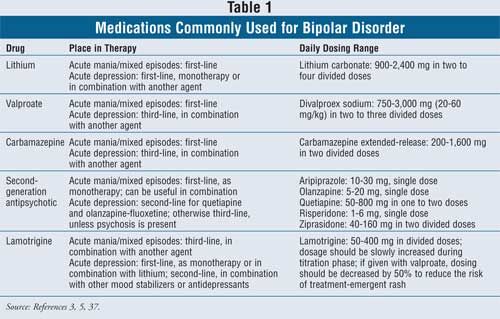 Goldberg, many doctors perceive it to be among the safer options when treatment benefit outweighs risk to the fetus, especially in women who are more prone to depression than mania. Like many psychotropic drugs, lamotrigine is secreted into breast milk, so women are advised to discuss with their doctors the risk and benefits of breastfeeding while taking lamotrigine.
Goldberg, many doctors perceive it to be among the safer options when treatment benefit outweighs risk to the fetus, especially in women who are more prone to depression than mania. Like many psychotropic drugs, lamotrigine is secreted into breast milk, so women are advised to discuss with their doctors the risk and benefits of breastfeeding while taking lamotrigine.
Lamotrigine is not recommended in patients who have demonstrated hypersensitivity to the medication or any of its ingredients.
As with any medication, Dr. Goldberg adds, allergic reactions to lamotrigine can occur. Get immediate emergency help if you show any signs of an allergic reaction, such as hives, facial or throat swelling, or difficulty breathing. Notify your doctor if you develop a skin rash, especially if it occurs within your mouth or on soft body tissue such as eyelids or around nasal openings, and if it is blistering, peeling, painful, burning, or involves a fever or sore throat. Be sure to report all medications you are taking to medical staff.
Lamotrigine Side Effects
Some people who take lamotrigine may experience adverse reactions or side effects. Serious side effects that should be reported immediately to your doctor include:
Any skin rash, blistering or peeling of skin
Painful (burning) sores in or around the mouth, eyes or genitals
Jaundice (yellowish skin or eyes)
Swollen gland, fever, severe muscle pain
Weakness, drowsiness, confusion
Stiff neck, headache
Increased sensitivity to light
Mood or behavior changes, such as depression, anxiety, agitation, hostility, restlessness, mental or physical hyperactivity, suicidal thoughts
Common side effects of lamotrigine that are not emergencies but should also be reported to your doctor include:
Headache or dizziness
Blurred or double vision
Dry mouth
Gastrointestinal distress such as nausea, vomiting, diarrhea or stomach pain
Fever, sore throat, runny nose
Drowsiness or fatigue
Tremor
Insomnia
The biggest risk with lamotrigine is a rare allergic reaction called Stevens-Johnson Syndrome, which can be fatal if left untreated. First a patient may experience flu-like symptoms of fever, cough or sore throat, then a rash or skin blistering will follow.
First a patient may experience flu-like symptoms of fever, cough or sore throat, then a rash or skin blistering will follow.
Most rashes have occurred within two to eight weeks of initiating treatment, and is more common in the pediatric population compared to adults. The risk of rash increases with higher starting doses, higher escalating doses and use of lamotrigine in combination with valproate. Early clinical trials and follow-up research showed that the overall incidence of any skin disorders was 11% to 12% in both bipolar I and bipolar II patients treated with lamotrigine. ²
Many medications can cause this reaction, including antibiotics like Bactrim and penicillin and over-the-counter medications like Tylenol and Motrin. Some ways to try to prevent lamotrigine rash include:
Dosing increases must be raised very slowly.
It should be stopped if any new rash or skin changes occur while you’re starting the medication, unless the rash is clearly known to be non-drug-related.
 (After the first 3 months the risk of Stevens-Johnson Syndrome declines to almost zero).
(After the first 3 months the risk of Stevens-Johnson Syndrome declines to almost zero).To avoid false-alarm rash confusion, the use of new soaps, getting a sunburn, exposure to poison ivy and starting any other new medications should be avoided during the first 3 months of starting lamotrigine.
With those steps, the risk of this severe rash is about 1 in 3,000 in adult patients; without them, it’s more like 1 in 100. "Unfortunately, there is still a high risk of non-serious, benign rashes (10% chance), so many people have to stop lamotrigine to be on the safe side," Dr. Aiken explains. "If you responded to lamotrigine but had to stop it because of a rash, it may be possible to restart at a lower dose."
Does lamotrigine interact with any medications or other substances?
Certain other drugs can affect the way lamotrigine works in your body by decreasing its effectiveness or delaying its excretion from your body. These include hormonal birth control methods, estrogen-containing contraceptives, hormone treatments, the antibiotic rifampin, seizure medications such as phenobarbital, and valproic acid, which is also used to treat bipolar disorder.
Your doctor will carefully prescribe and monitor your dosage when lamotrigine is taken with other treatments. Avoid alcohol, cannabis, and other substances that can increase dizziness or drowsiness while taking lamotrigine. To rule out dangerous side effects, discuss all other medications or mind-altering substances you consume with your doctor before taking lamotrigine.
One recent British study found that folic acid supplements can cancel out lamotrigine’s benefits (Geddes et al., 2016). "No one expected that result, as folic acid usually helps depression, and other medications, like valproate (a mood stabilizer approved for mania associated with bipolar disorder, seizures/epilepsy, and migraine headaches)," says Dr. Aiken. "More research is needed before we can fully trust this result, but until then, we recommend taking lamotrigine without any folic acid supplements, including those found in multivitamins. Once you’re doing well on lamotrigine, if you decided to add folic acid, watch out for a potential loss of benefits. "
"
Is it OK to suddenly stop taking lamotrigine?
It is NOT recommended to discontinue lamotrigine abruptly, as this may increase risk of seizures. Consult your doctor before stopping lamotrigine. If you do stop for more than a few days, DO NOT restart at your current dose. Call your doctor to review your dosing schedule.
- MedlinePlus. Lamotrigine. Last revised January 15, 2019. Available at: https://medlineplus.gov/druginfo/meds/a695007.html. Accessed October 10, 2019.
- Terao T, Ishida A, Kimura T, Yarita M, Hara T. Preventive effects of lamotrigine in bipolar II versus bipolar I disorder. The Journal of Clinical Psychiatry. September 1, 2017; 78(8): e1000-e1005. Available at: www.psychiatrist.com/JCP/article/Pages/2017/v78n08/16m11404.aspx. Accessed October 10, 2019/
Notes: This article was originally published January 24, 2016 and most recently updated June 8, 2022.
Women's Bipolar Disorder - Anxiety and Depression
Bipolar disorder is equally common in both men and women. However, in women, BAD may have its own characteristics.
However, in women, BAD may have its own characteristics.
Contents
Symptoms of bipolar affective disorder in women
- Bipolar II disorder is more common in women
- And this means that they are more likely to have hypomania, rather than full-blown mania.
- This also means that we see more depression in women. nine0010
- Rapid cycling is more common in women
- Among comorbid mental disorders in women, the following disorders are more common: borderline personality disorder, anxiety disorders, eating disorders, alcohol dependence.
- Among somatic diseases, women are more likely to suffer from migraines, diabetes, hypertension, thyroid disease, and obesity.
- Menstruation and menopause can trigger an episode of illness. nine0010
Treatment considerations for bipolar disorder in women
We have translated a chapter from The Bipolar Disorder Survival Guide (Second Edition, 2011). This chapter is titled "Women Only".
For women, bipolar disorder brings additional challenges. Each stage of life - puberty, pregnancy, menopause - requires you to rethink your treatment regimen. At the same time, the treatment of the disease sometimes requires drugs that can adversely affect your health and the health of your child. nine0003
Mood-stabilizing medications can affect the development of the baby in utero (teratogenic risk), but harm from untreated bipolar disorder can be even greater, so the risks should always be carefully assessed. In this chapter, we will address all of these issues.
If you are planning a pregnancy, it is especially important to choose safe drugs.
Here is what bipolar women write:
“I've always had a lot of worries about periods, birth control pills, physical changes when taking medication - they made me feel fat and stupid. But the most difficult decision was whether to continue taking medication during pregnancy. And when I finally took it, my psychiatrist said that he did not know how to select drugs for pregnant women and advised me to turn to someone else. But not only that, my usual gynecologist said the same thing! nine0002 My husband insisted that I stop taking medication. And I didn't know what to think. When I stopped taking the pills and got pregnant, I felt worse. There was a new attack of the disease, and I ended up in the hospital. Fortunately, the baby was born healthy. But, looking back, I think that qualified help would definitely not hurt me. ” But not only that, my usual gynecologist said the same thing! nine0002 My husband insisted that I stop taking medication. And I didn't know what to think. When I stopped taking the pills and got pregnant, I felt worse. There was a new attack of the disease, and I ended up in the hospital. Fortunately, the baby was born healthy. But, looking back, I think that qualified help would definitely not hurt me. ” 43-year-old patient with bipolar I disorder. |
| “My boyfriend thinks PMS is to blame. But that's not the case at all. I'm much, much worse. It feels like bipolar disorder and PMS reinforce each other several times and plunge me into panic, aggression, deep longing, which are not typical even for me. nine0002 A 27-year-old female with bipolar II disorder. |
“The antidepressants I was prescribed for my severe menopause caused rapid weight gain. So I came up with more truthful names for them: depa-pig, olanza-zhirin, longing-don. So I came up with more truthful names for them: depa-pig, olanza-zhirin, longing-don. 52-year-old woman with bipolar II disorder. |
If you are a woman, bipolar disorder is an additional challenge for you. nine0048
It significantly influences how the different stages in the development of the female body go. You may face the same problems as these women.
Mood-stabilizing medications can affect your baby's development in utero (teratogenic risk), but harm from untreated bipolar disorder can be even greater, so the risks should always be carefully assessed.
Every stage of your reproductive life - puberty, pregnancy, menopause - requires you to rethink your bipolar disorder treatment regimen. nine0048
Moreover, the treatment of the disease sometimes requires drugs that can adversely affect reproductive health. In this chapter, we will address all of these issues.
To find the best treatment, it is important to know the following:
- Women are more likely to suffer from depression that is longer, more frequent and resistant to treatment than men.
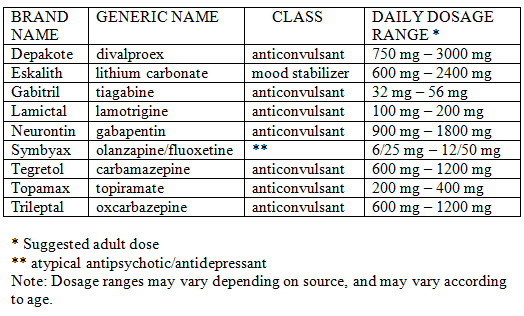
This means you may be misdiagnosed with recurrent depressive disorder. This means that you risk missing out on years of adequate treatment. On average, women start taking lithium several years later than men. nine0010 - Mixed episodes, rapid cycling, and bipolar II disorder are more common in women.
They are treated with complex combinations of drugs (usually mood stabilizers and atypical antipsychotics) that can affect your health (eg cause weight gain). - Women are more likely to experience episodes of mania or hypomania provoked by antidepressants.
- Because women are more prone to depression, doctors often prescribe them only antidepressants. This may provoke mania, hypomania, or a mixed episode. nine0010
- Women are more likely to have physical problems associated with bipolar disorder.
- Migraines, headaches, thyroid disorders can complicate the course of bipolar disorder.
- In women, drugs are more likely to cause weight gain, as well as an increase in blood cholesterol and insulin resistance.

- Bipolar disorder itself greatly affects a woman's health during pregnancy and after childbirth, as well as the menstrual cycle. nine0023
- bipolar disorder
- impulse control disorders
- personality disorders such as borderline personality disorder or histrionic personality disorder
- lithium
- sodium valproate (Depakote)
- lamotrigine (lamictal)
- topiramate (Topamax)
- gabapentin (Neurontin)
- Depakote: potential liver damage
- Lithium: potential effects on kidneys and thyroid
- Lamictal: potential for Stevens-Johnson syndrome
- Topiramate: Potential problems with finding words, kidney stones, or changes in the taste of carbonated drinks.
- fluoxetine (Prozac)
- paroxetine (Paxil)
- sertraline (Zoloft)
- escitalopram (Lexapro)
- citalopram (Celexa)
You may be interested in: Antidepressants and pregnancy
Bipolar disorder is often combined with weight gain, diabetes, PCOS, PMS. Women with bipolar disorder have a very high risk of developing postpartum depression. These comorbid disorders often require separate medication and other care.
How does treatment affect women?
But the good news is that you can benefit from the latest science in researching the biological and physiological aspects of living with bipolar disorder (see Burt & Rasgon, 2004; Cohen, 2007; Kenna et al., 2009).; Marangell, 2008; Rasgon et al., 2005; and Joffe, 2007.)
Scientists have gathered enough information about which medications are safest in pregnancy and what are the risks of stopping them abruptly. We have this knowledge thanks to research not only on bipolar disorder, but also on epilepsy, which has been treated for many years with anticonvulsants: divalproex (Depakot), carbamazepine (Tegretol), lamotrigine (Lamiktal).
Today we know more than ever about the effects of mood stabilizers on reproductive functions, particularly the menstrual cycle. We also know how important family and spouse support are to a woman's recovery from an episode of bipolar disorder. We also know that different types of couples and family therapy can prevent the return of depression and alleviate it
symptoms. (Miklowitz, 2008).
So science and education are on your side. As you struggle, remember the rule emphasized in the title of this book: Successful treatment involves constant interaction with your doctor and family members. In many situations, there are no clear right answers, and this can be frustrating. You will most likely have to make different decisions at different stages of life. But knowing the advances in the treatment of bipolar disorder will help you make an informed choice. Understanding the problem will give you a sense of greater control over your health and the health of your child. nine0003
Pregnancy is probably the most difficult topic for women with bipolar disorder.
Menstrual cycle in women with bipolar disorder
Bipolar disorder and medications affect the course of the menstrual cycle. Typical violations are the absence of menstruation for some time (amenorrhea), cycles longer than 35 days (oligomenorrhea), irregularity of cycles. Irregular cycles (shorter than 25 days or longer than 35) occur in 15-20% of all women.
Research. Cycle disorders are more common in women with bipolar disorder (occur in 35% of them) than with depression (25%) or healthy women (20%). (Hadine Joffe and colleagues, 2006, Massachusetts General Hospital).
Is this normal?
Your doctor should study your cycle over time, especially if you are gaining weight due to medications or have cycle problems. The causes of violations can be natural: adolescence, breastfeeding, the onset of menopause. But there are also pathological causes: polycystic ovaries, increased prolactin levels, lack of thyroid hormones, neoplasms in the anterior pituitary gland, too much exercise, weight loss, severe stress. nine0003
nine0003
Prolactin levels
High prolactin levels are dangerous because they increase the risk of breast cancer and can lead to a drop in estrogen levels. Low levels of estrogen can cause infertility and increase the risk of osteoporosis.
Rising prolactin levels cause irregular cycles, galactorrhea (milk secretion from the breast), lack of menstruation, migraines, decreased sexual desire.
Some antipsychotics can increase prolactin levels. Between 44 and 88% of people taking risperidone suffer from it. Typical antipsychotics (eg, chlorpromazine and haloperidol) can also cause a rise in prolactin. nine0003
If you have a family history of breast cancer, it is especially important to control your prolactin levels.
If you have high prolactin and cycle problems, you may want to change your medication (such as quetiapine, aripiprazole (Abilify), or ziprasidone (Geodon). If you find both high prolactin and low estrogen, a hormonal contraceptive may help to increase it.
Choice of contraceptives
Planned pregnancy will allow you to better control the disease and the health of your baby, so effective contraception is especially important for you.0003
You also need to be aware that oral contraceptives and drugs for bipolar disorder can affect each other. Certain anticonvulsants, including carbamazepine, oxcarbazepine (Trileptal), and topiramate (Topamax), increase the metabolism of sex hormones and birth control pills. This means that they reduce the effectiveness of contraceptives. If you are taking them, you should choose another method of contraception, such as condoms, a cap, or high estrogen pills. nine0003
In addition, birth control pills can make some drugs less effective, such as lowering the blood levels of lamotrigine. So you should change your method of contraception or increase the dosage of lamotrigine. If you take this mood stabilizer and suddenly stop taking contraceptives, its blood level may rise sharply, which can be dangerous. Be sure to tell your psychiatrist which contraceptives you are using.
Be sure to tell your psychiatrist which contraceptives you are using.
Menopause and bipolar disorder
| “The onset of menopause was hell for me. I've spent years balancing with HRT when the doctor suggests I stop taking estrogen. Doesn't he understand that my life will then turn into complete chaos? 52 year old bipolar II patient |
There are few studies on the impact of bipolar disorder on menopause.
Menopause is known to be a risk factor for episodes. One study showed that 20% of bipolar women in menopause report an increase in mood swings. Every third person developed a fast cyclicity. (Blehar et al., 1998).
Of course, not all mood swings after menopause are caused by hormones.
There may be other reasons: divorce, illness, death of parents and other stressful events. If you are in your late 50s and are experiencing symptoms of depression or mania, check your hormone levels: FSH, estradiol, thyroid hormones, luteinizing hormone, and discuss with a psychiatrist whether treatment needs to change. Psychotherapy or a psychological group can help you cope with the changes in your life. nine0003
Psychotherapy or a psychological group can help you cope with the changes in your life. nine0003
Menstrual Cycle Depression Study
A Harvard study of 1,000 women found that depressed women had earlier periods. In addition, their menopause occurred earlier, especially if they experienced severe depression and took antidepressants. These women also differed from healthy women in their higher levels of follicle-stimulating hormone, luteinizing hormone, and lower levels of estrogen.
Important: If your mood continues to worsen after menopause, you may need higher doses of an atypical antipsychotic. nine0048
It may also be necessary to reduce the dose of lamotrigine due to its effect on estrogen levels.
Some women decide to take hormone replacement therapy (usually take estrogen and progesterone). There is evidence that it may help stabilize mood and reduce hot flashes (Freeman et al., 2002). Such therapy has other benefits, such as increased bone strength.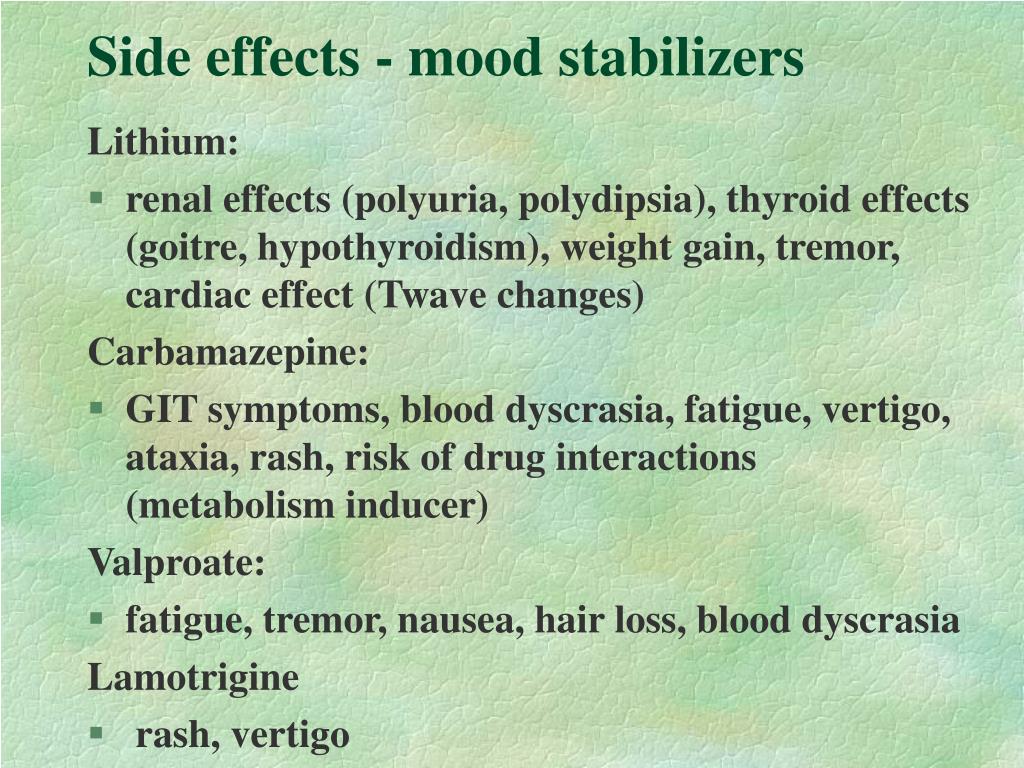
But there have been cases of women experiencing mania or rapid cycling after starting hormone replacement therapy (Arnold, 2003). In addition, therapy increases the risk of breast cancer and heart disorders. nine0003
Continued chapter on pregnancy and childbirth.
Ask the Expert: What Are Mood Stabilizers for Bipolar Depression and How Do They Work?
What are mood stabilizers?
There is more than one class of psychotropic drugs with mood stabilizing properties, such as atypical antipsychotics and antiepileptics.
Mood stabilizers are a group of drugs used for several reasons. In particular, they modulate various moods, both high (mania) and low (depression). nine0003
The term "mood stabilizer" generally refers to drugs that also have anticonvulsant properties and are traditionally used to treat conditions with elements of emotional dysregulation, such as:
General mood stabilizers include:
impulse control disorders such as intermittent explosive disorder) or to reduce the dose of a substance.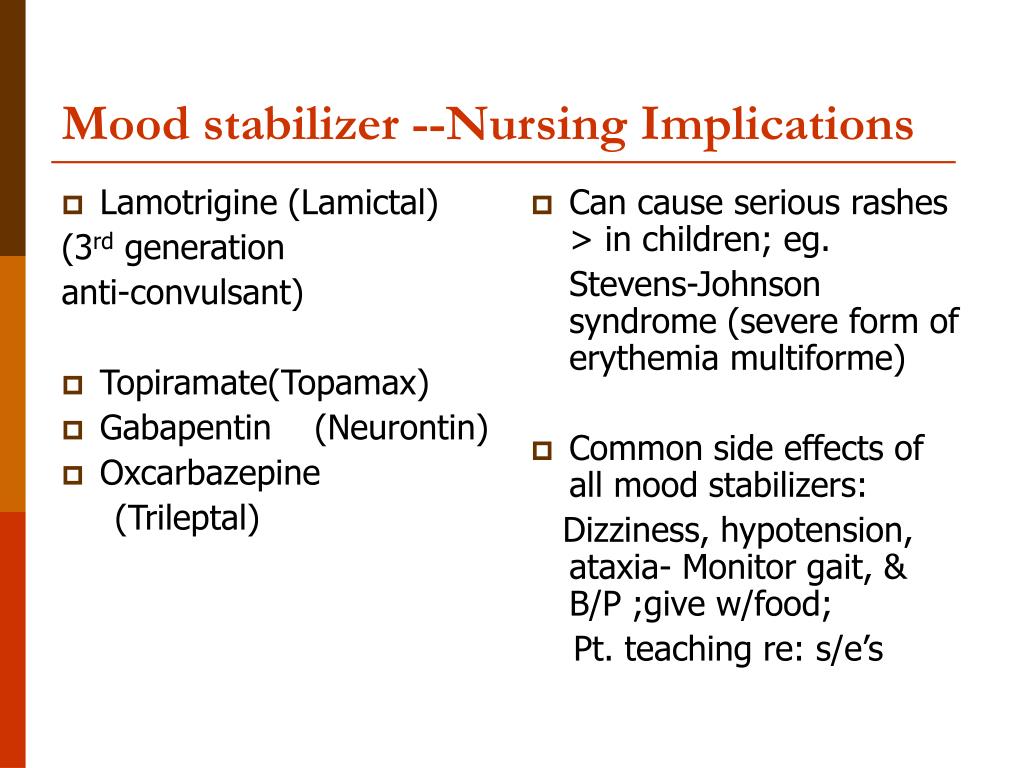
How do mood stabilizers work in bipolar depression?
It is not known exactly how these drugs work in mania or bipolar depression. nine0003
It is likely that the stabilization of membrane concentration gradients in the central nervous system stops the flow of charged particles along these gradients and suppresses the nerve impulse.
This theoretical principle explains the ability of these drugs to modulate mood, but may also explain other clinical applications such as seizure control or drug dose reduction.
For bipolar disorder, mood stabilizers can help with depressive symptoms. They are sometimes combined with antidepressants while the person is on a mood stabilizer to prevent manic episodes or mixed episodes. nine0003
Are there such things as homeopathic mood stabilizers?
In theory, any substance that stabilizes the membrane and keeps charged particles from moving down the concentration gradient could have mood-stabilizing properties.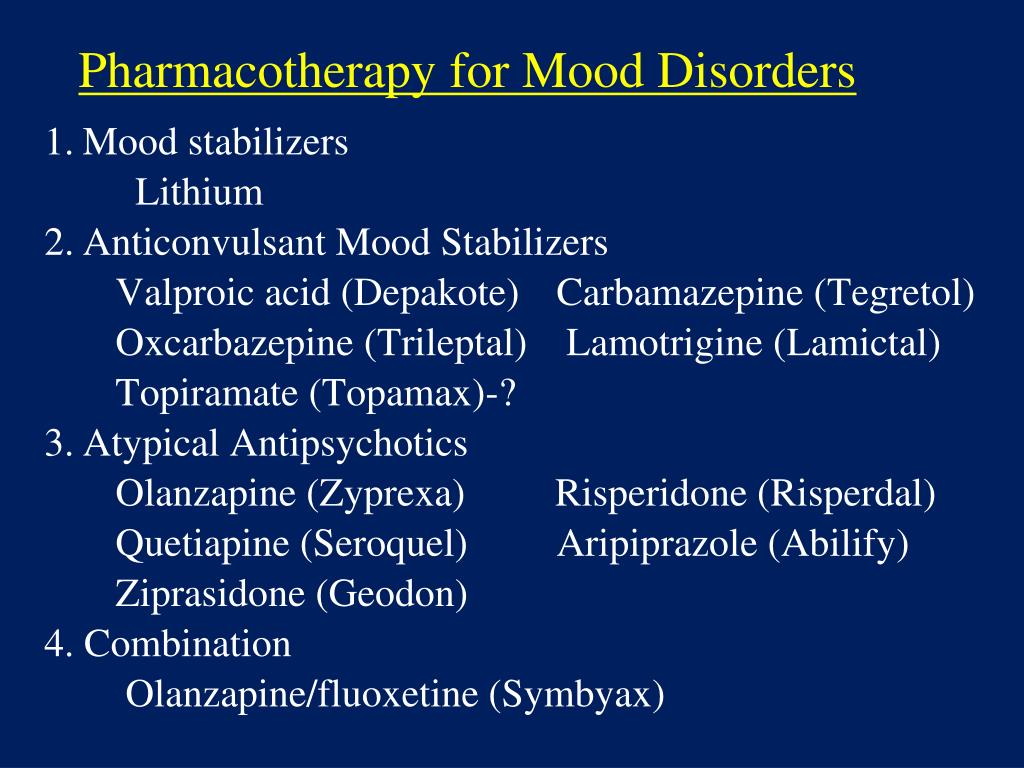
Valerian Root may function as a low-potency alternative to more traditional drugs such as Depakote or GABA (a neuropeptide in your central nervous system that has a depressant effect). nine0003
GABA-boosting products may be an alternative to gabapentin (a prescription mood stabilizer). Omega-3 fatty acids, as well as N-acetylcysteine (NAC), are other substances purported to have mood-stabilizing properties.
It's best to check with your doctor before trying any new supplements instead of medications.
What are the side effects of mood stabilizers?
This physiological mechanism for stabilizing membrane systems by promoting conduction delay will allow you to predict possible therapeutic benefits as well as side effects. nine0003
This applies to most organ systems and may include side effects such as constipation, sedation or conduction delay.
Each mood stabilizer may have additional side effects unique to the drug, as opposed to the usual general class of drugs.![]() Examples of this may include:
Examples of this may include:
Please note that these are not all side effects that may occur with these drugs. Talk to your doctor about other side effects you may experience.
Can I get mood stabilizers over the counter?
Some products, such as St. John's wort, can be found in health food stores or pharmacies. They are readily available without a prescription and include substances such as omega-3 fatty acids, NAC, and valerian root. nine0003
These may be good additional measures, but you should discuss this with your doctor if you are considering adding supplements to your treatment regimen.
It may not be appropriate to rely on over-the-counter alternatives instead of traditional medicines.![]() Additional alternatives may interfere with the action of drugs or increase side effects.
Additional alternatives may interfere with the action of drugs or increase side effects.
What is the difference between mood stabilizers and antidepressants?
Generally, mood stabilizers are also used for epileptic seizures or migraines. This includes:
Atypical neuroleptics such as Latuda or Zyprexa may also be used to stabilize mood. Doctors usually prescribe lamictal as a mood stabilizer, but they may also prescribe it off label for bipolar depression.
The term antidepressant is traditionally used to refer to selective serotonin reuptake inhibitors (SSRIs). This includes:
Serotonin and norepinephrine reuptake inhibitors (SNRIs) include venlafaxine (Effexor) and desvenlafaxine. Other antidepressants include bupropion (Wellbutrin) and mirtazapine (Remeron).
All formal antidepressants increase serotonin, norepinephrine or dopamine levels.














